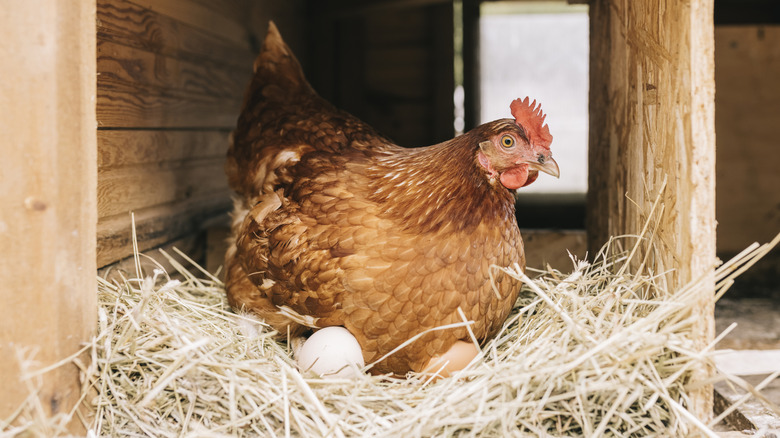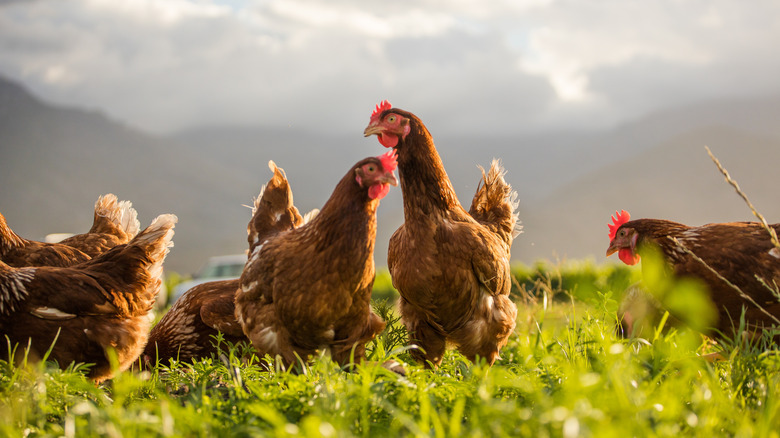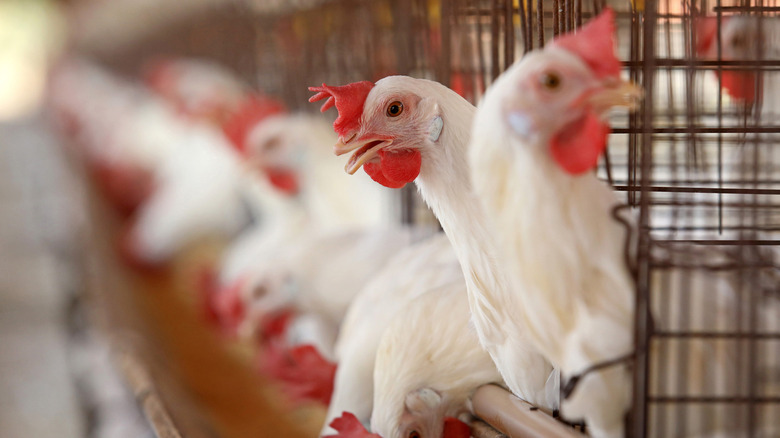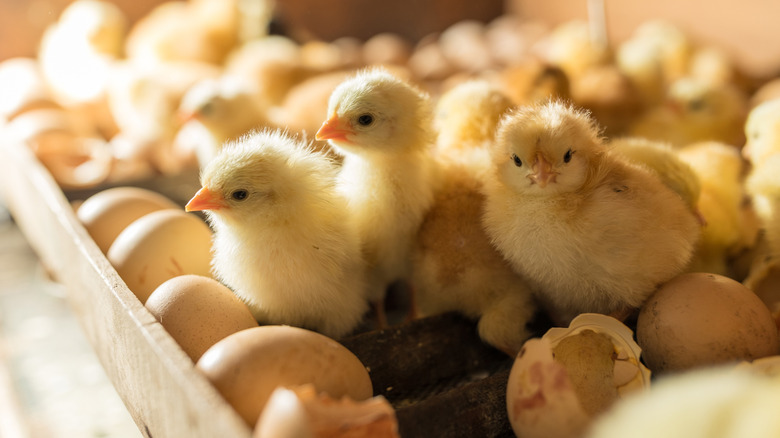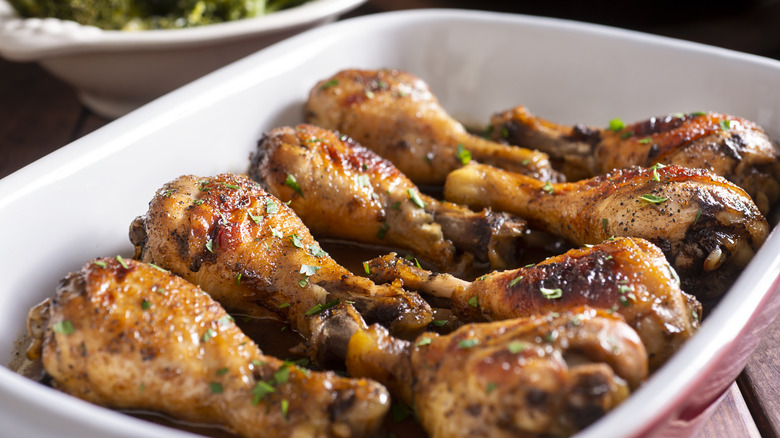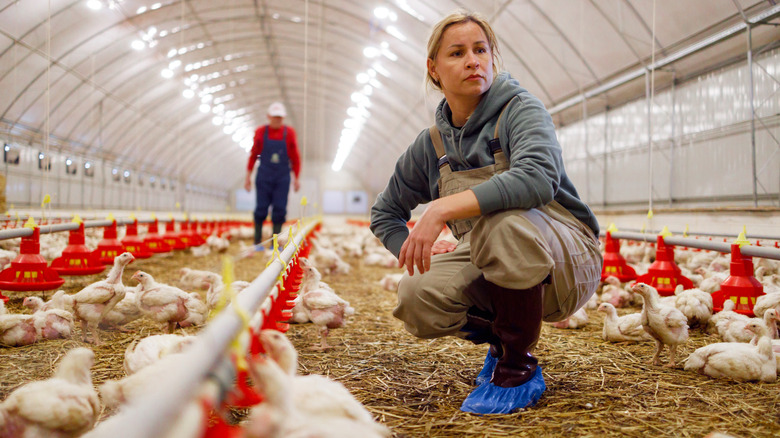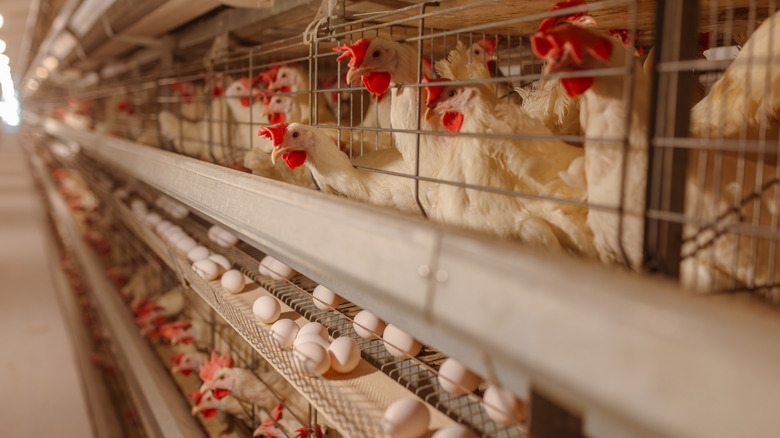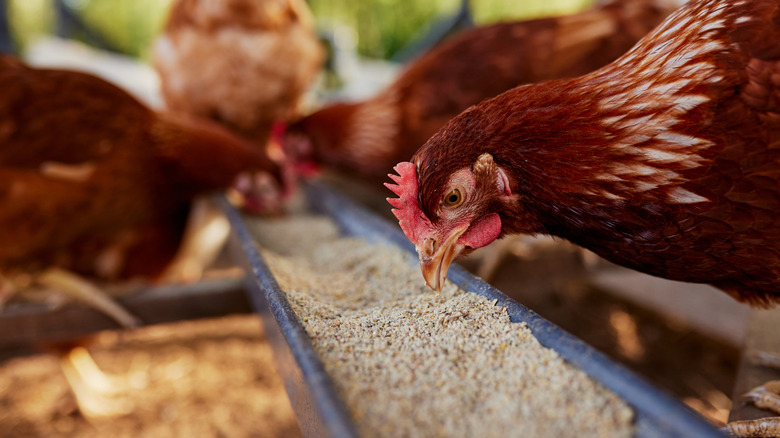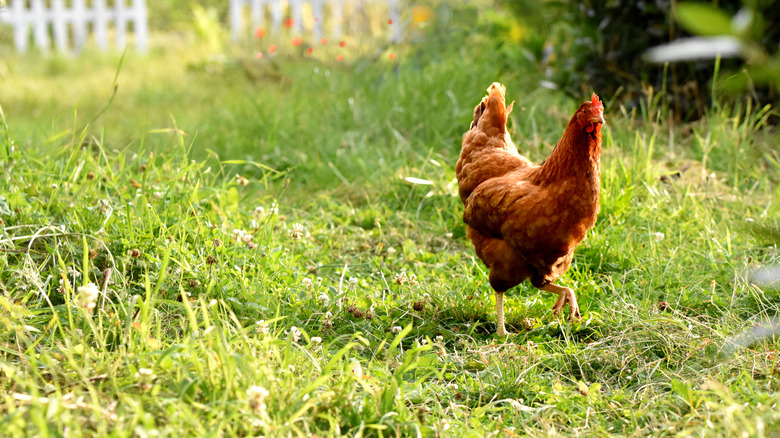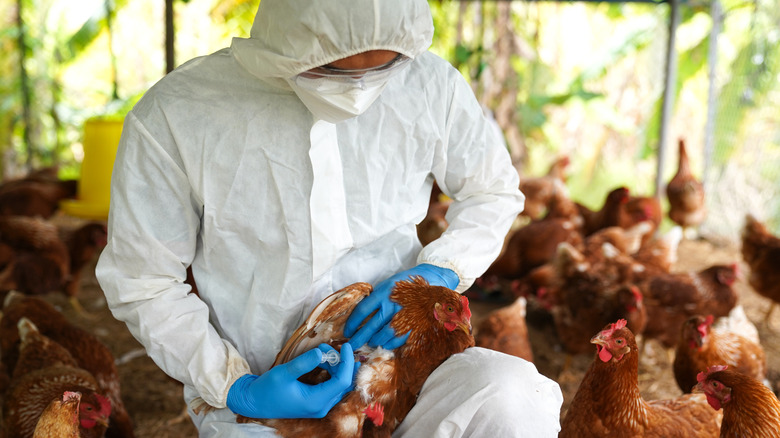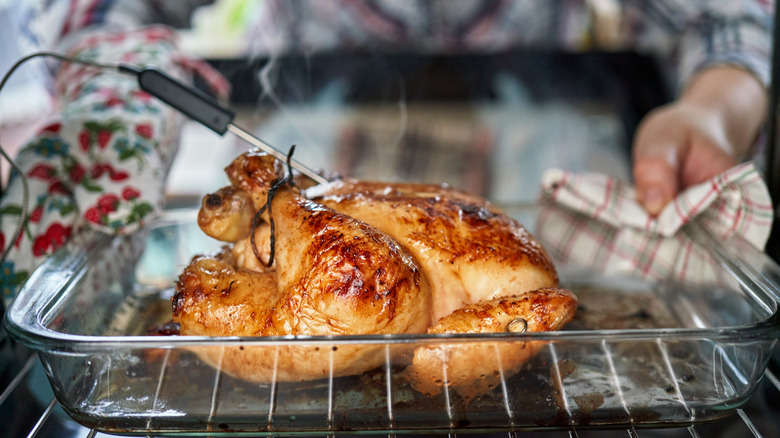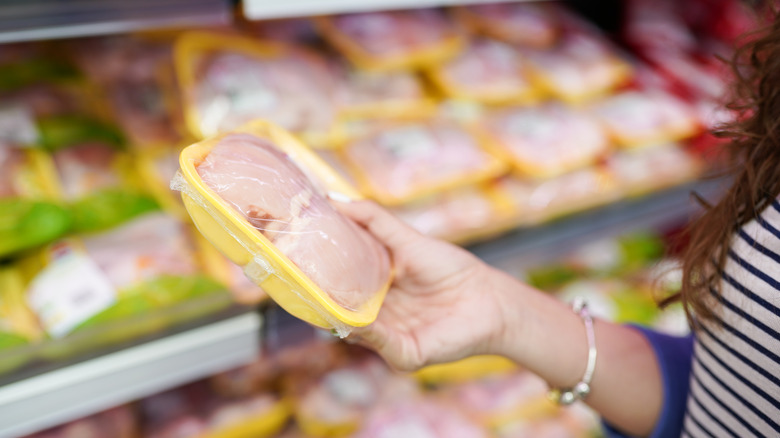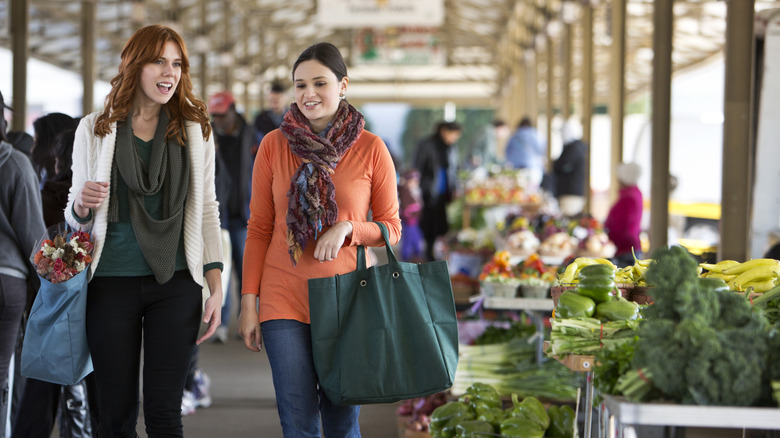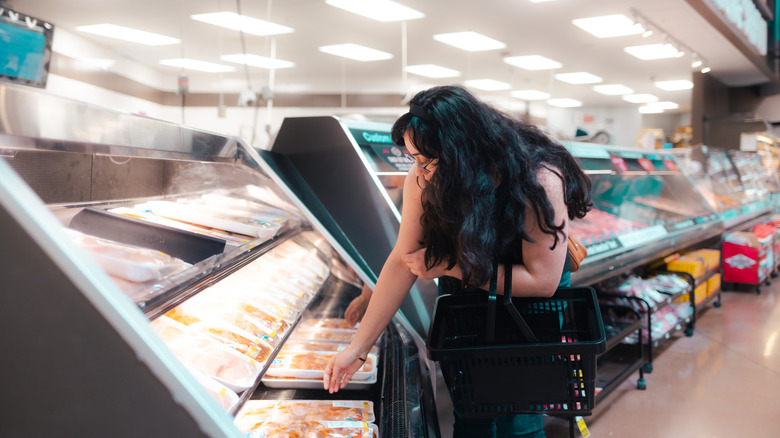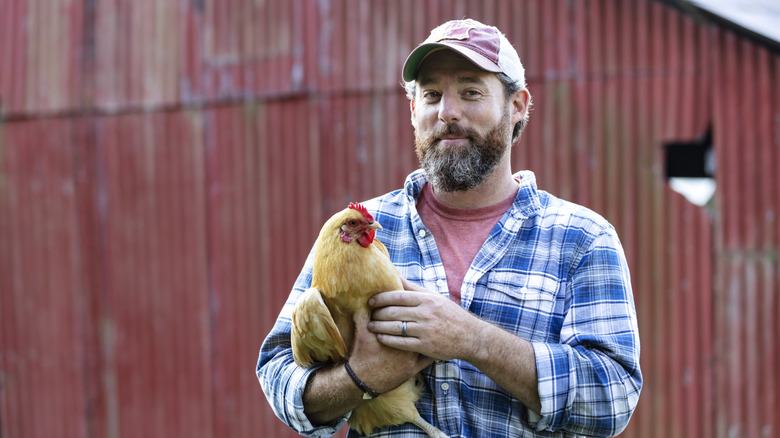The Secret Side Of Chicken Farming, According To Poultry Insiders
When you think of chicken farming, what do you envision? While you might hope that the nuggets in your Happy Meal started out as a fluffy white bird gracefully pecking around a pastoral landscape, that's probably not the reality and, for some, that's the furthest thing from their minds when they think of chicken farming. Instead, they envision rows upon rows of caged birds crammed together in dark and depressing confinement. However, the truth of chicken farming isn't all horrible, nor is it all great. Like most industries, chicken farming is doing some things right and some things very wrong.
To get the skivvy on the secret side of chicken farming that most consumers aren't familiar with, we conducted exclusive interviews with five poultry insiders representing an array of backgrounds and various styles of chicken farming. These are the facts about chicken farming that they think you need to know.
The majority of chicken farms are small, family farms
Chicken farming isn't always a massive, corporate operation. In fact, according to the U.S. Department of Agriculture (USDA), as of 2020, most of the country's poultry products, including eggs, were produced by small farms. Overall, the USDA said that family farms accounted for 98% of all farms and 88% of all production. Small family farms specifically accounted for about 50% of all farms (The USDA defines a "small" family farm as one with less than $350,000 in annual gross revenue).
Furthermore, according to the National Chicken Council, which responded to a request for comment for this article and which represents the broiler chicken industry (or chickens raised for meat versus eggs), about 95% of all broilers are produced on family farms — and that's a lot of chicken. In 2023, the industry produced nearly 10 billion broiler chickens, and the United States boasts the largest broiler industry in the world, frequently exporting chickens to other countries.
Sometimes family farms work for big corporations
That said, it's worth noting that while family farms produce a majority of the country's chickens, these farms are not always working independently. Don't automatically assume that these family farms are peddling their chickens at the local farmers' market as their main source of income. Instead, many work for "big chicken." According to the National Chicken Council, about 25,000 family farmers have contracts with larger companies, to produce chickens on their behalf — and while this can produce much-needed income, it can also come with downsides.
Julia Johnson, U.S. head of food business for Compassion in World Farming explained, "The chicken industry is vertically integrated, meaning that the large chicken companies own everything but the barns — they control the feed, the processing plants, and even the chickens themselves. Farmers are contracted to grow birds for these large companies but do not have any say in how to manage these animals, leading them to lose their autonomy as farmers and [become] beholden to these chicken corporations."
The average factory-farmed chicken only lives about 40 days
How old do you think the average chicken is when it makes its way from the farm to the freezer? It's probably a lot younger than you think. Johnson told us that the typical factory farm chicken only lives to be a little more than a month old — 40 days, on average. However, these chickens have been genetically selected to grow quickly over that time span, so the growth rate is far disproportionate to the actual age of the chicken. As Johnson said, "At this expedited growth rate, this would be [as] if a human toddler was 300 pounds!"
Initiatives to counter this practice are in the works (like the Better Chicken Commitment). Changes to chicken genetics could mean that the chickens grow more slowly — but just slightly so — and therefore live better lives (Johnson noted that the 40-day chickens "can barely stand or walk"). The farmers might have to wait about a week longer for the chickens to be ready for harvest, but the difference in animal welfare would be significant.
The biggest health risk caused by eating chicken can be mitigated by thoroughly cooking it
What's the biggest health risk that comes with eating factory-farmed chicken? While you might point to the various antibiotics and other pharmaceuticals that chickens are treated with before processing (and these are definitely worth consideration), Giovana Vieira, senior animal welfare scientist at The Humane League, pointed primarily to a risk that we're all likely familiar with: food poisoning.
"Consuming chicken carries certain health risks, mostly associated with the consumption of chicken that was not cooked properly or if cross-contamination occurs during handling. Raw poultry products frequently contain pathogenic organisms such as Salmonella, Campylobacter, and Clostridium perfringens, all of which are among the top five pathogens causing foodborne illnesses," she said. About a million Americans become ill each year due to eating contaminated poultry, and poultry accounts for the highest number of foodborne illness outbreaks and hospitalizations.
Luckily, avoiding this risk, according to the Centers for Disease Control and Prevention, is as simple as ensuring your chicken is thoroughly cooked and avoiding cross-contamination from raw chicken.
Working on a large-scale chicken farm can be dangerous
When we consider the chicken farming industry and the health risks posed, we often think of risks to the chickens and consumers — but what about risks to the employees? Working on a large-scale chicken farm can be dangerous for myriad reasons.
Dayne Alexander, senior corporate research lead at The Humane League, pointed to a few of the hazards that poultry production workers face. For one, poultry facilities produce dust filled with feather and skin debris from the chickens, dried feces, and more. When inhaled, this dust can raise the risk of a range of issues, from asthma to lung disease to organic dust toxic syndrome, an illness that comes with flu-like symptoms and is heavily prominent in the agricultural industry, with up to 40% of workers having developed the illness at some point (via Iowa Health & Human Services). Exposure to poultry manure also poses a risk and can lead to respiratory disorders and disease.
Poultry factory farms are bad for the environment
Both Vieira and Alexander from The Humane League pointed to a variety of negative impacts poultry factory farms have on the environment. While this might not be exactly news to you, you may be surprised at how far-reaching the environmental impact is.
For starters, they explained, poultry farming requires a large amount of land not just for the actual farm facilities, but also to produce the food for the poultry. Johnson said that factory-farmed chickens are mostly fed corn and soy, which require certain agrochemicals to grow, which then causes further environmental issues, including unhealthy topsoil that is easily washed away, taking those agrochemicals with it into our water supply. As this land is claimed, deforestation and habitat loss occurs. Factory poultry farming requires a large amount of water as well, and waste runoff from these farms can contaminate the nearby soil and water sources. Meanwhile, emissions from poultry waste negatively impact air quality in the nearby surroundings, and poultry farms emit greenhouse gases that contribute to global warming.
Vieira and Alexander noted, "The estimated environmental impact of chicken production adds up to an annual per capita cost of 404 pounds carbon dioxide equivalent (CO2e); 1,690 square feet [of] habitat loss; 15,500 gallons of water; and 117 pounds of manure."
The chicken industry is working to reduce its environmental footprint
The chicken industry is working hard to reduce its environmental footprint. In fact, Tom Super, senior vice president of communications for the National Chicken Council, told us that reducing that footprint is one of the industry's biggest achievements.
While chicken production already has the least impact on the environment when compared to other animal agriculture, a 2020 study found that, when looking at the broiler industry, land use in the industry has been reduced by 13%, greenhouse gas emissions are down 18%, water consumption is down 13%, fossil resources usage is down 22%, and particulate-forming emissions are down 22%. Additionally, small chicken farmers (so those not in league with so-called "big chicken") are even more conscientious of their environmental footprint, as is the case at the American Pastured Poultry Producers Association, where the more than a thousand active member farms use a process known as the pastured poultry model that reduces farming's impact on both land and chickens.
More than 500 chicken companies have signed the Better Chicken Commitment
The chicken farming industry is working to improve via initiatives like the Better Chicken Commitment (BCC). According to Julia Johnson, the BCC is a set of standards that helps better the lives of chickens, touching on their living environments, welfare genetics, and eventual ends. Thus far, more than 230 North American companies and more than 300 European companies have committed to the BCC. The benefits aren't just for the chickens, though. The family farmers who have contracted with major chicken companies also appreciate the initiative.
Johnson said, "By giving birds a bit more space to move around and play, enrichments to engage with or perch on, and brighter barns, often with windows to allow for natural light, these healthier birds can have a better quality of life and express their natural behaviors. We have been told consistently by farmers that they appreciate growing these chickens because the barns are dryer, there are lower mortality rates, and it is more enjoyable to see birds running and playing, rather than barely being able to stand up." She said that she and the Compassion in World Farming team are confident that the BCC can become adopted across the entire U.S. poultry farming industry.
Bird flu isn't a food safety concern for consumers
You may have seen a lot of headlines recently about the bird flu and could be worried about the possible health effects. However, "it is not a food safety concern," said Super, of the National Chicken Council. "All flocks are tested prior to leaving the farm. If a flock tests positive, it does not enter the food chain. Regardless, proper cooking would destroy the virus, and according to the CDC, the risk of humans contracting avian influenza is very low."
That said, that doesn't mean you should completely ignore bird flu. According to Mike Badger, of the American Pastured Poultry Producers Association, bird flu outbreaks require entire flocks to be euthanized, and that can lead to disruptions in the chicken supply chain, which can lead to price increases. However, shopping from independent farmers who are less likely to be as highly impacted by industry disruptions, whether that be a bird flu outbreak or even something like the COVID-19 pandemic, can mitigate these concerns.
The label on your chicken matters
Not all chicken is raised equally, and the label on your chicken matters. Different terminology can mean different living conditions and treatment for animals, so brushing up on the various categories of chicken — i.e., "organic" vs. "pasture-raised," etc. — can be helpful.
For example, according to Badger, while pastured poultry producers do not have a specific regulatory arm like certified organic products might, there are still differences and standards across the board. He said, "For us, our idea of 'pastured' is going to [mean], essentially, in broad terms, the bird is living the majority of its life on pasture. They're going to be moved frequently to fresh pasture, and the pasture is going to actually consist of vegetation that has roots. In some cases, with organic [chicken], there may be porches that constitute [chickens'] outdoor access, and it might have wood chips or cement. [Organic] doesn't stipulate that, but we want pasture that is vegetative and rooted."
Demand for healthier chicken is up
According to Johnson, demand for healthier, more humane chicken is up. She pointed to proof that the organic chicken market has grown "by double-digit percentages in four of the past five years," and that the market is expected to reach $14.5 billion in value in the next 10 years. "Consumers want antibiotic-free chicken and we would encourage all chicken producers to see this trend as the future, only treating animals when they are sick, rather than routinely giving them subtherapeutic antibiotics," she said.
In some cases, though, this demand for organic chicken isn't necessarily all about humane treatment or antibiotic-free products. Some feel that the growing popularity in organic chicken is due to increased beef prices, which could persuade shoppers to look at their other options. Others point to a growing focus on healthy living overall, which drives demand for organic products of all types. The National Chicken Council likewise points to the growing buying power of younger consumers, who are more likely to value organic and antibiotic-free labels than their parents might have.
The biggest challenge for small chicken farmers is consumer awareness
For small chicken farmers who produce pastured chicken independently, without a contract from a large corporation, Badger said one of the biggest hurdles is consumer awareness. In addition to finding the right consumers for their products, they also have to find consumers who value what they produce — and who are willing to pay a higher price for that value. He compared pastured chickens to craft beers — not only are pastured chickens produced on a more limited scale, but they also boast differences in flavor.
"You have mass-produced beers," he described. "They're one price, and you have artisan and handcrafted [microbrews] that are a different price ... Pasture-raised poultry is more like that artisan handcrafted [beer] because it's [produced] in smaller quantities. A typical [pasture-raised poultry] farm might produce 5,000–10,000 chickens a year...but on average, a typical contract farm might [produce] 20,000 chickens every six to eight weeks. The scale is radically different and that's part of the price."
Both factory-farmed chicken and chicken raised locally on small farms have benefits
Speaking with all the experts for this article, it was clear that, while the chicken farming industry isn't perfect, there are some benefits to both factory-farmed chicken and chicken raised on a smaller scale, via local, independent farmers. With the latter, obviously, consumers enjoy an often higher-quality product, raised more humanely and with less of a significant impact on the environment. However, all of those admirable qualities come with a price — and that's where factory-farmed chicken swoops in.
Factory-farmed chicken is just more affordable and more convenient. You swing by the poultry case at your grocery store, toss your purchase in your cart, and move on with your day. Depending on what cut of chicken you buy, you could have multiple meals at a cost of just a few dollars. When compared to beef and pork, the price of chicken is just a fraction of what you'll pay for other proteins — and during a time in which affording groceries is a struggle, that matters.
There's probably an independent chicken farmer near you
The good news is that if you don't want to purchase factory-farmed chicken, you don't have to. There's probably an independent chicken farm located closer to you than you might think. To help you find them, the American Pastured Poultry Producers Association created a website called Get Real Chicken with educational videos on pasture-raised chicken and a directory map that lists hundreds of producers located throughout the United States. In addition to finding chicken farmers close to you, you can also find farmers that will ship to you.
"I think the best approach," Badger said, "regardless of what you're buying, is to get as close to the source as possible ... so that you can ask questions. You can make a list of things that are important to you. Are you concerned with what the chicken eats? If so, you can ask the farmer who grew that chicken exactly what they feed their chicken. Are you concerned with having birds that were raised in a pastured model? ... It's much easier to go to your local grocery store ... However, the pasture-raised product inside the grocery store, at least the mainstream ones ... isn't going to live up to a pastured ideal."
